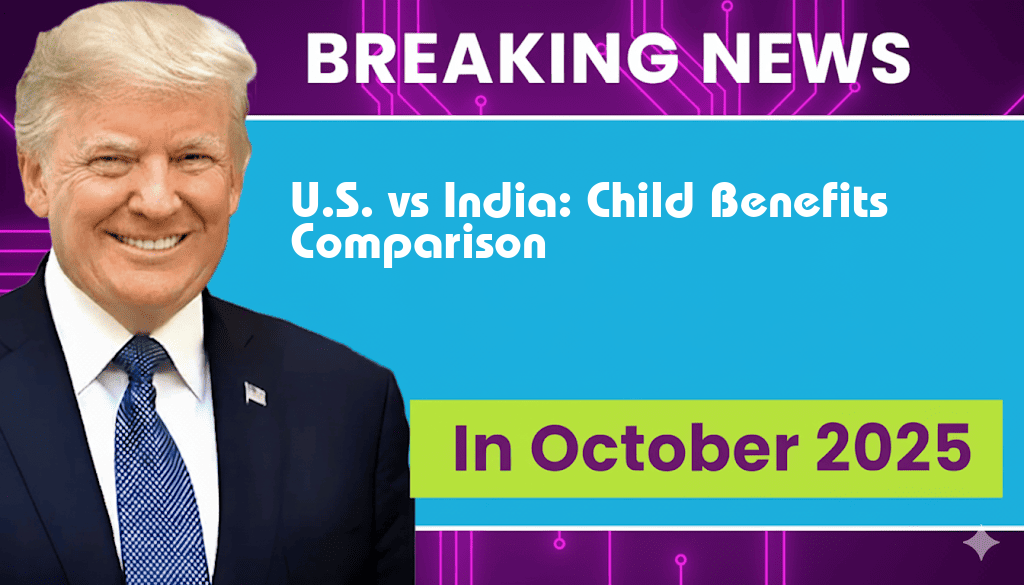A recent comparison of child benefit programs in the United States and India reveals stark contrasts in financial support available to families. In the U.S., families can receive a child tax credit of up to $2,200 per child, while in India, the equivalent financial assistance amounts to approximately ₹1,65,000 per year for families with eligible children. These figures raise important questions about the effectiveness and reach of child benefit policies in addressing the needs of families in two of the world’s largest economies. As both countries continue to grapple with issues related to poverty and child welfare, understanding the implications of these benefits is crucial for policymakers and families alike.
The Child Tax Credit in the United States
In the United States, the Child Tax Credit (CTC) is designed to provide financial relief to families with dependent children. The credit was made more generous in recent years, especially during the COVID-19 pandemic, when the American Rescue Plan increased the amount families could claim.
Key Features of the U.S. Child Tax Credit
- Amount: Up to $2,200 per child under 17 years old.
- Eligibility: Available to families whose incomes fall below certain thresholds.
- Refundable: The credit is partially refundable, meaning families can receive a portion even if they owe no taxes.
As of 2023, families can benefit from the CTC as part of their annual tax filing, allowing them to receive a substantial amount that can aid in covering everyday expenses, education costs, and childcare.
Child Benefits in India
India has implemented various initiatives to support families, one of which is the Direct Benefit Transfer scheme that includes child benefits. The government provides financial assistance that can total up to ₹1,65,000 (approximately $2,000) based on various factors including the number of children and family income.
Key Features of Indian Child Benefits
- Amount: Up to ₹1,65,000 per child annually, subject to eligibility criteria.
- Eligibility: Targeted towards low- and middle-income families.
- Implementation: Funds are typically transferred directly to the bank accounts of beneficiaries.
This scheme aims to improve the financial stability of families and ensure that children receive necessary nutrition, education, and healthcare.
Comparative Analysis
| Feature | United States | India |
|---|---|---|
| Annual Benefit Amount | $2,200 per child | ₹1,65,000 per child (~$2,000) |
| Refundable Credit | Yes | No |
| Eligibility Criteria | Income-based thresholds | Income-based and family size |
| Direct Transfer | No | Yes |
Impact on Families
The financial support provided by these child benefits plays a crucial role in shaping the lives of children and their families. In the U.S., the CTC allows families to allocate funds towards educational expenses, healthcare, and childcare, which can enhance the quality of life and opportunities for children. Conversely, in India, the direct transfer of funds can help alleviate immediate financial burdens, particularly for families in rural areas who often face higher living costs and limited access to resources.
Conclusion
As both nations continue to refine their child benefit programs, the effectiveness of these financial supports will depend on their ability to reach those in need and provide meaningful assistance. Policymakers in both countries may draw lessons from each other’s experiences as they strive to improve the welfare of children and families.
For more details on the U.S. Child Tax Credit, visit IRS Child Tax Credit. To learn more about India’s child benefit schemes, refer to the Wikipedia entry on Direct Benefit Transfer.
Frequently Asked Questions
What is the amount of the child benefit credit in the U.S.?
The child benefit credit in the U.S. is $2,200 per qualifying child, aimed at providing financial support to families.
How much is the child benefit in India?
In India, the government offers a child benefit of ₹1,65,000 for eligible families, which is designed to assist with the costs of raising children.
How do the child benefits in the U.S. and India compare?
The child benefits in the U.S. and India differ significantly, with the U.S. providing $2,200 and India offering ₹1,65,000, reflecting the varying economic conditions and priorities in each country.
What are the eligibility requirements for child benefits in both countries?
Eligibility for child benefits varies by country. In the U.S., families must meet certain income thresholds, while in India, benefits may depend on family size and income level as well.
Are there any additional benefits provided along with the child credits?
Yes, both countries may offer additional support programs alongside child benefits, such as educational grants and health care subsidies, to further assist families.

Leave a Reply